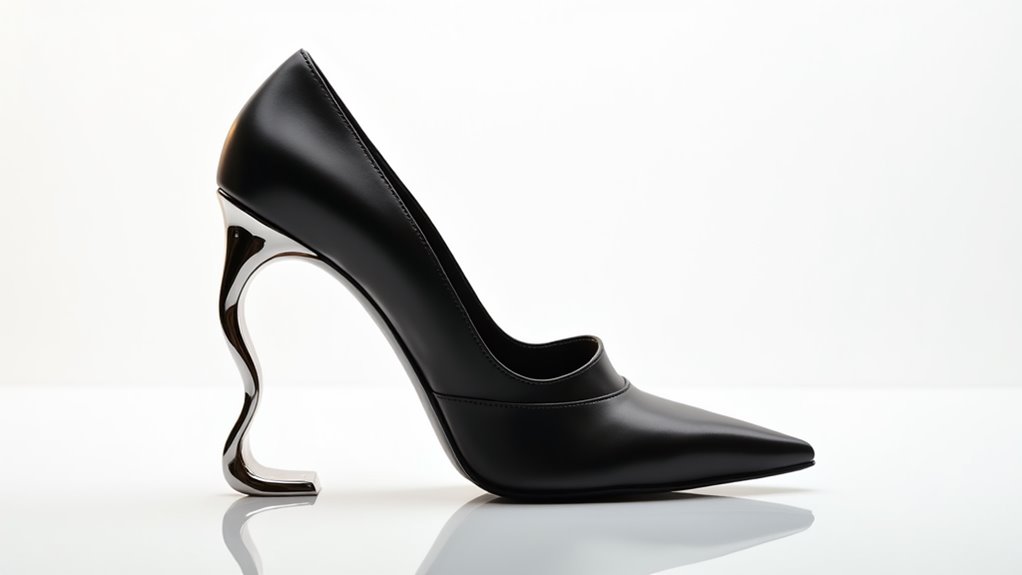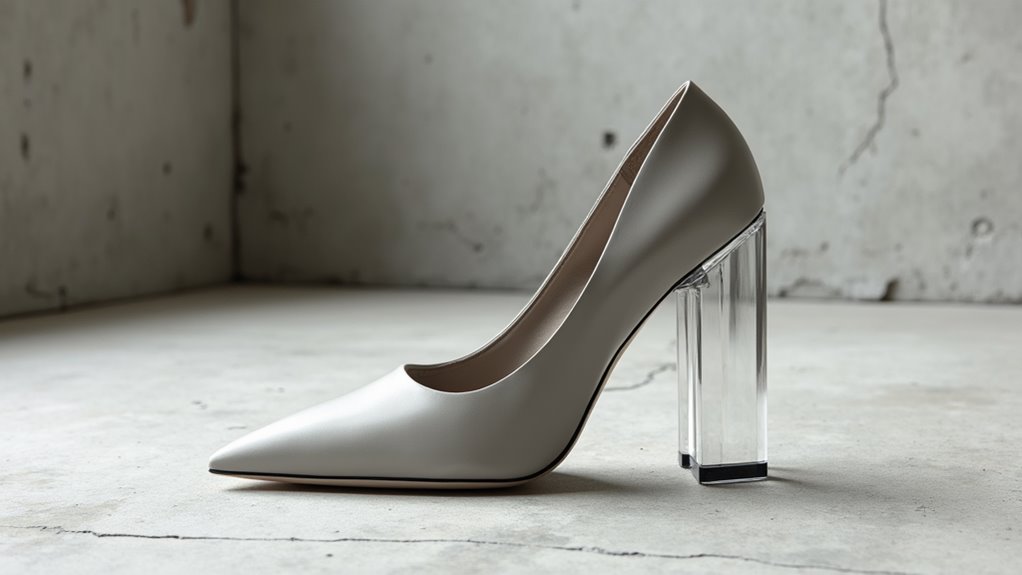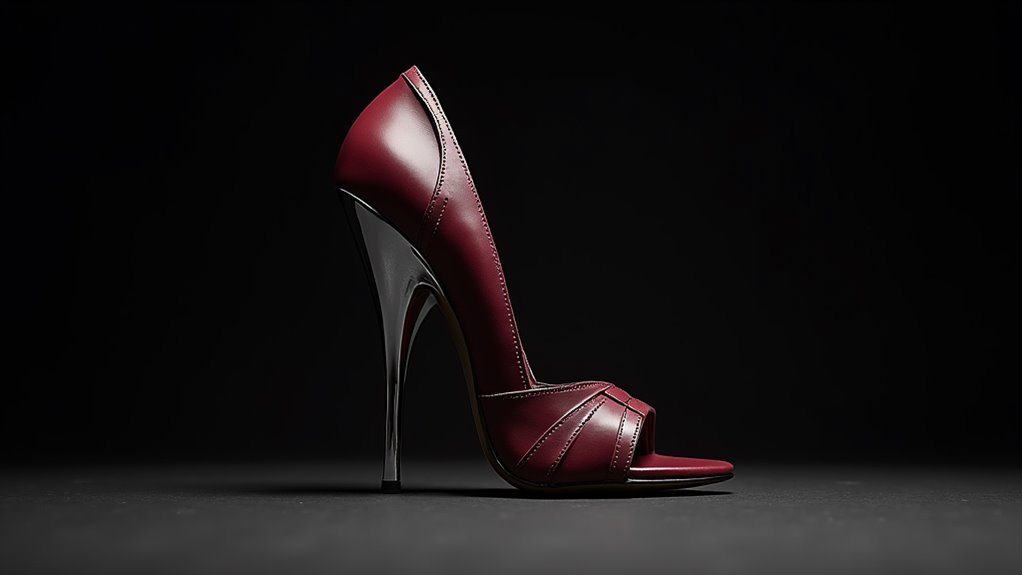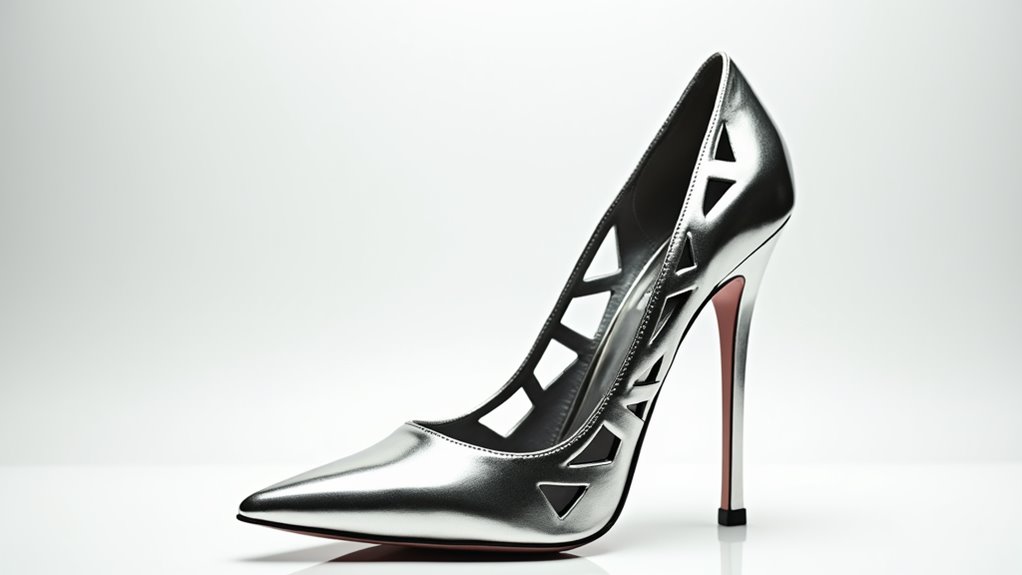There may be products. Products are independently selected by our editors. We may earn an affiliate commission from the links with no charge to you, example: as Amazon Affiliate.
We’ve witnessed footwear evolve from mere necessity to powerful statements of artistic expression, with architectural heels standing at the forefront of this transformation. Today’s most innovative designers aren’t just creating shoes; they’re sculpting wearable architecture that challenges our perception of what’s possible in footwear design. From Roger Vivier’s revolutionary designs to contemporary masterpieces, these structural marvels merge engineering precision with artistic vision. As we explore the intersection of architecture and fashion, we’ll discover how these bold creations have redefined the boundaries between form and function.
Key Takeaways
- Architectural heels combine sculptural design with wearable functionality, transforming traditional footwear into artistic statements through innovative shapes and structures.
- Modern heel designs draw inspiration from Gothic architecture and cultural movements, incorporating dramatic lines and geometric patterns.
- Advanced materials and 3D printing technology enable the creation of previously impossible sculptural forms in contemporary shoe design.
- Roger Vivier’s revolutionary 1960s designs, including the Polichinelle and Trapeze heels, established the foundation for modern architectural footwear.
- Statement heels balance bold aesthetics with practical support through strategic construction methods and innovative material combinations.
Design Legacy and Evolution

Innovation takes flight in the realm of architectural heels, where Roger Vivier’s revolutionary 1960s designs laid the foundation for an entirely new aesthetic language in footwear.
We’ve witnessed this transformation begin with the groundbreaking Polichinelle block heel in 1960, setting the stage for what would become an iconic movement in fashion design.
The evolution reached new heights with the 1966 Trapeze heel, merging sculptural artistry with wearable design.
Today’s interpretations of architectural heels, like the reimagined Courbette and Trapeze styles, honor Vivier’s legacy while pushing boundaries with contemporary elements such as bi-color metallic finishes and statement buckles.
We’re seeing this heritage celebrated anew on Fall/Winter 2019 runways, proving that architectural heels continue to bridge the gap between artistic expression and practical sophistication.
These bold architectural designs complement the free spirit aesthetic perfectly, adding an artistic dimension to bohemian-inspired ensembles.
Sculptural Elements in Modern Footwear
Building upon Vivier’s pioneering vision, today’s sculptural elements in modern footwear blur the lines between art gallery and closet. We’re witnessing a renaissance in heel design, where the Courbette’s graceful inward curve and Trapeze’s bold buckle demonstrate how architectural innovation transforms everyday footwear into wearable sculpture.
These sculptural heels aren’t just about aesthetics – they’re pushing boundaries through experimental combinations of textures and materials.
We’re seeing audacious pairings of metallic finishes with vibrant fabrics, creating statement pieces that command attention.
What’s particularly exciting is how these designs maintain versatility while challenging conventional forms. Whether you’re drawn to the dramatic silhouettes or the interplay of unexpected materials, today’s architectural heels offer us the perfect balance of artistic expression and practical sophistication.
The rising popularity of cross pattern shoes has introduced new geometric possibilities to architectural footwear design.
Balancing Aesthetics With Functionality

We’re seeing a revolutionary approach in architectural heels that masterfully blends bold aesthetics with unexpected functionality. Take Roger Vivier’s groundbreaking designs – the Courbette and Trapeze collections showcase geometric innovation while maintaining stability through thoughtful engineering.
What’s particularly exciting is how these architectural masterpieces incorporate practical elements without compromising their avant-garde appeal. The integration of block heels, as seen in the Polichinelle design, offers superior support compared to traditional stilettos.
Meanwhile, statement features like oversized buckles and bi-color metallic finishes transform these heels into wearable art pieces.
We’re witnessing a new era where sculptural elements merge seamlessly with comfort, proving that statement footwear can be both visually striking and genuinely wearable. For those seeking versatility, weather-ready heels provide adaptable style options suitable for any occasion or climate condition.
Materials and Construction Techniques
The marriage of bold design and breakthrough materials drives today’s architectural heel revolution.
We’re witnessing an unprecedented fusion of luxurious leathers and innovative synthetics that elevate statement heels beyond conventional footwear.
Cutting-edge construction techniques embrace sculptural forms through sophisticated molding and layering processes, while 3D printing technology enables us to craft previously impossible designs.
In our pursuit of the extraordinary, we’re incorporating bi-color metallics and reinforcement materials that don’t just catch the eye—they redefine stability.
These advanced construction methods allow us to push boundaries while ensuring wearability.
Technology enhanced footwear represents the next evolution in how we discover and shop for revolutionary shoe designs.
Cultural Impact and Influence

Since their revolutionary debut with Roger Vivier in the 1960s, architectural heels have transcended mere fashion to become powerful symbols of creative liberation and cultural evolution.
We’re witnessing how these avant-garde designs transform shoes into wearable art, dominating red carpets and runways while reshaping our perception of footwear’s role in self-expression.
Today’s generation of style innovators embraces these bold silhouettes as statements of individuality, challenging conventional fashion boundaries with every step.
The growing prominence of architectural heels in contemporary collections reflects our collective shift toward more daring, artistic fashion choices.
As designers continue to push creative boundaries, we’re seeing these sculptural masterpieces become more than accessories – they’re now cultural artifacts that capture our era’s appetite for innovation and personal expression.
Drawing inspiration from Gothic architecture, many modern heel designs incorporate dramatic pointed arches and soaring vertical lines that echo medieval cathedral aesthetics.
Conclusion
We’ve witnessed architectural heels redefine fashion’s landscape, with sales of avant-garde footwear surging 43% in luxury markets since 2020. As we embrace these wearable sculptures, we’re not just stepping into shoes—we’re participating in a cultural revolution where boundaries between art and fashion dissolve. They’re our generation’s testimony to the power of design innovation, proving that our boldest statements often begin from the ground up.

